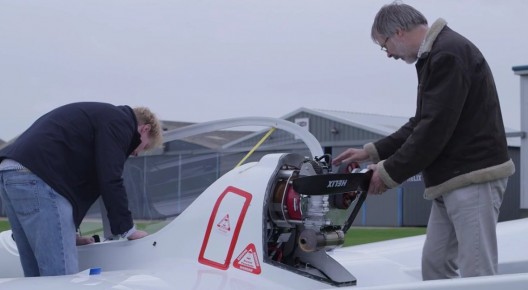Dr. Paul Robertson of the University of Cambridge has been sorting out the necessary components and relationships to make hybrid-electric-gasoline aircraft a practical reality for the last several years.
His Photonics and Sensors group at the University researches many areas of optics and electronics, including holography and “nano-photonic structures,” with hybrid flight last on the long list of studies. The blog has been reporting on his aeronautical activities since 2009, including what turned out to be the second and third electric aircraft flights in England, and the first flight of an electric-gas hybrid in a modified Alatus motorglider.
The current aircraft uses larger power components and is a bit more sophisticated. In fact, an external view would not give away the uniqueness of what nests inside. Its operation has a unique flavor, too – it’s the first ever, according to reports, that can recharge its batteries in flight.
The parallel hybrid system, built by Cambridge technicians, can pull power from the gas engine and the electric motor simultaneously to drive the propeller, and uses up to 30-percent less fuel “than a comparable plane with a petrol-only engine.” During take-off and climb, when maximum power is required, the modified Honda engine and custom lightweight motor work together to power the plane, “but once cruising height is reached, the electric motor can be switched into generator mode to recharge the batteries or used in motor assist mode to minimize fuel consumption. The same principle is at work in a hybrid car.”
Cambridge’s Engineering Department designed and built a power electronics module to “control the electrical current to and from the batteries – a set of 16 large lithium-polymer cells located in special compartments built into the wings. The petrol engine is optimally sized to provide the cruise power at its most efficient operating point, resulting in an improved fuel efficiency overall.”
The demonstration aircraft is based on the Czechoslovakian “Song” ultralight, a slim twin-boom machine available in an electric-only version from ElectraFlyer in the United States, and in its “petrol” version in Canada from Melody Aircraft.
Robertson analyzes why we haven’t seen a hybrid aircraft before now. “Although hybrid cars have been available for more than a decade, what’s been holding back the development of hybrid or fully-electric aircraft until now is battery technology. Until recently, they have been too heavy and didn’t have enough energy capacity. But with the advent of improved lithium-polymer batteries, similar to what you’d find in a laptop computer, hybrid aircraft – albeit at a small scale – are now starting to become viable.”
Funding came from Boeing, a member of Sustainable Aviation, a UK group committed to a net reduction in CO2 emissions of 50 percent 2005 levels by 2050. Marty Bradley, Boeing’s principal investigator for the program, explains, “Our mission is to keep our sights on finding innovative solutions and technologies that solve our industry’s toughest challenges and continually improve environmental performance. Hybrid electric is one of several important elements of our research efforts, and we are learning more every day about the feasibility of these technologies and how they could be used in the future.”
Test flights for the project took place at the Sywell Aerodrome, near Northampton, with Paul Dewhurst, Robertson’s long-time electric flying partner, doing the honors. These tests consisted of a series of “hops” along the runway, followed by longer evaluation flights at a height of over 1,500 feet.
Robertson’s team includes PhD students Christian Friedrich and Andre Thunot and MEng student Tom Corker, who will have an interesting “first” to include in their resumes. We wish them and their mentors continued success in a most promising endeavor.

